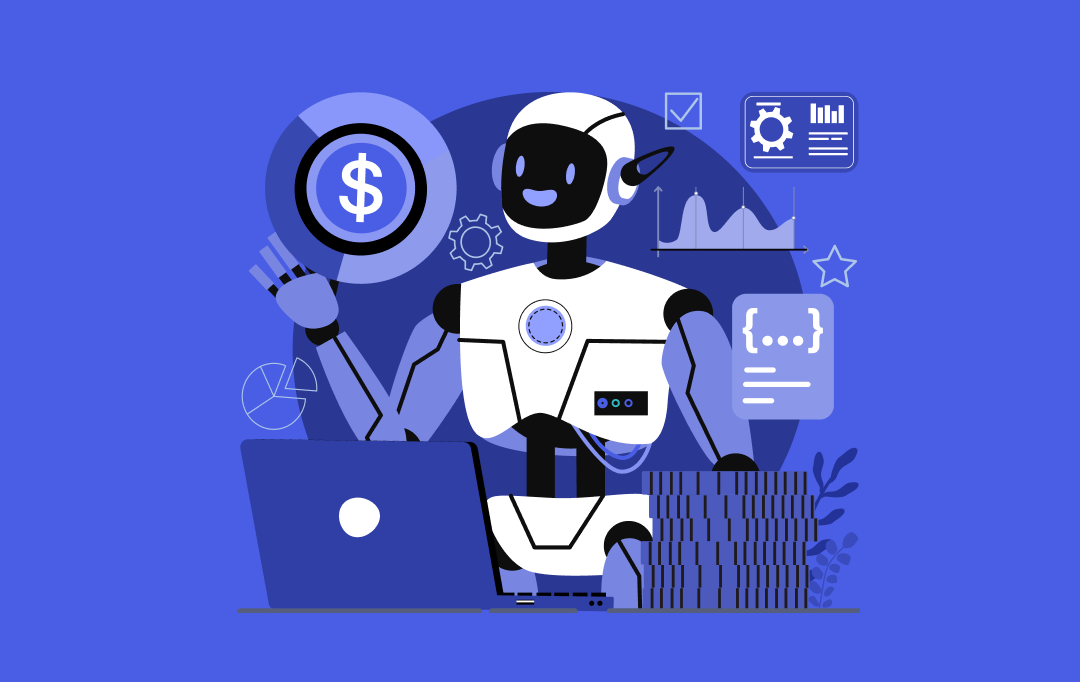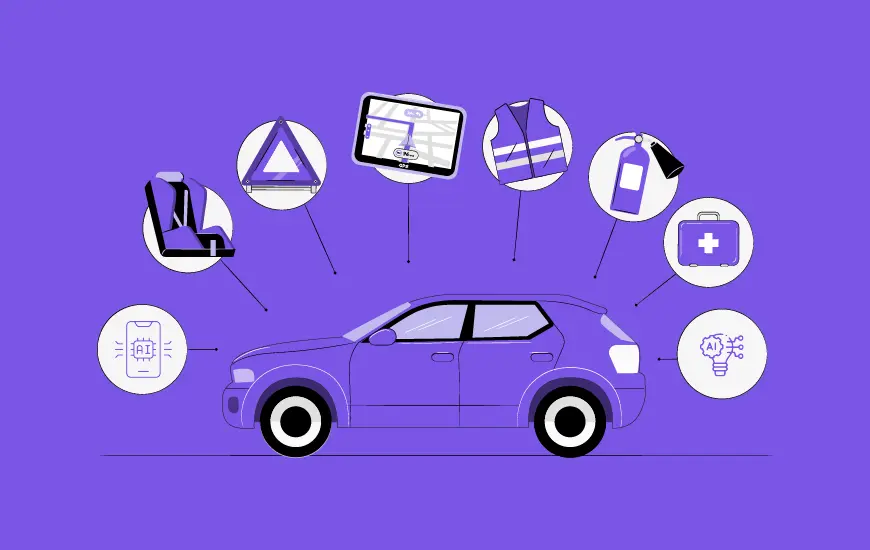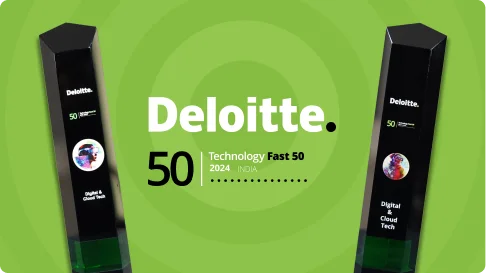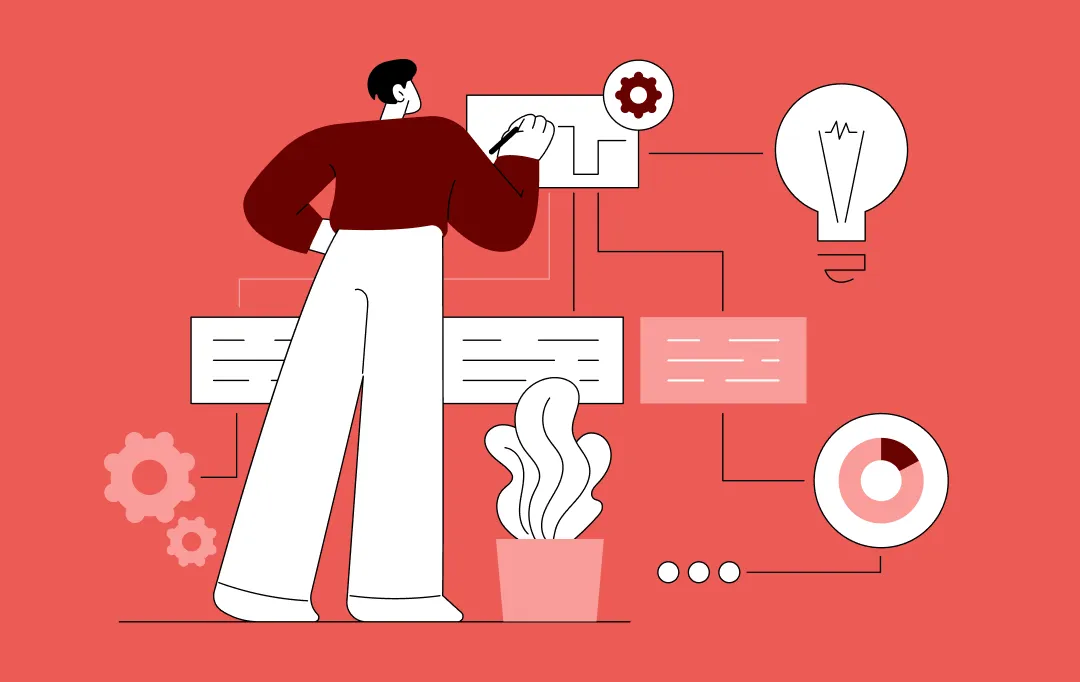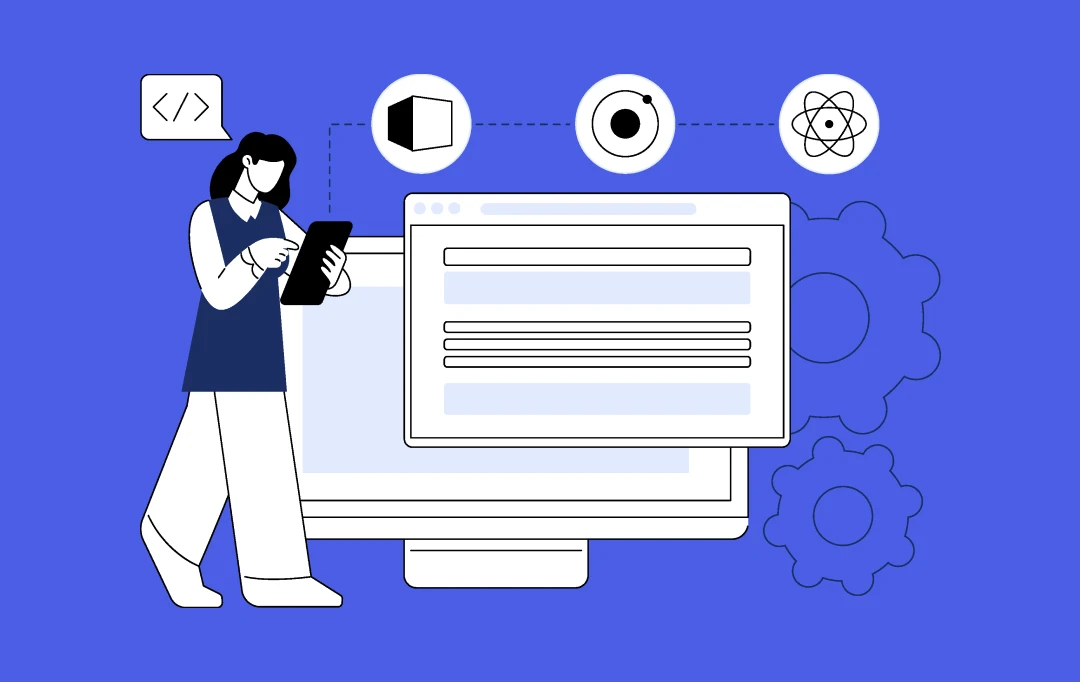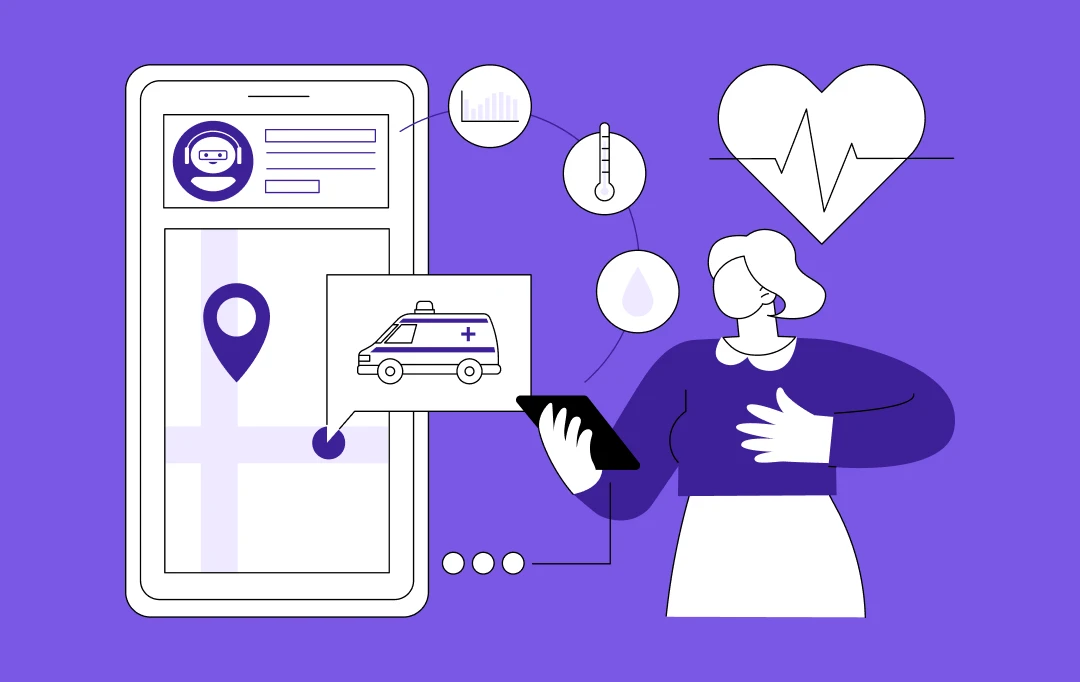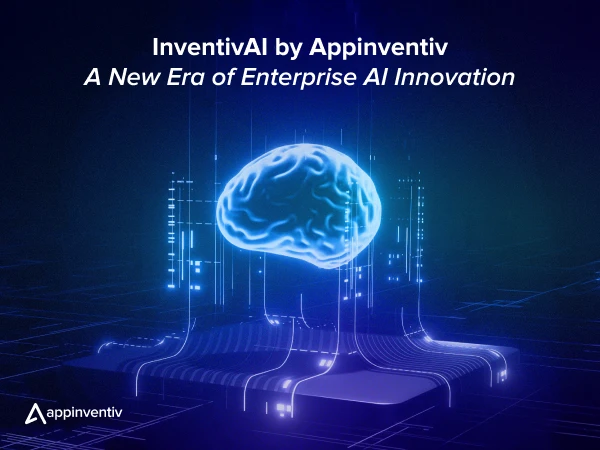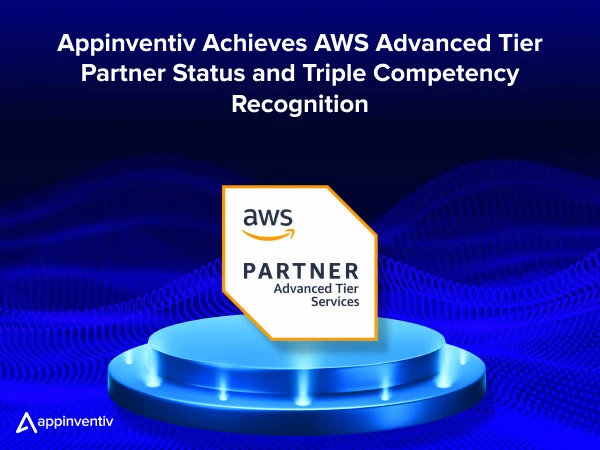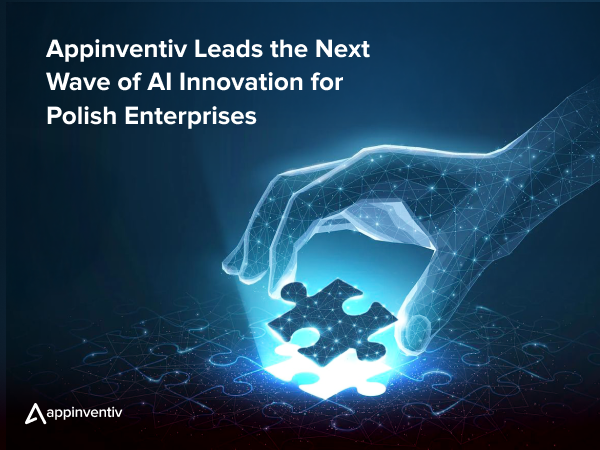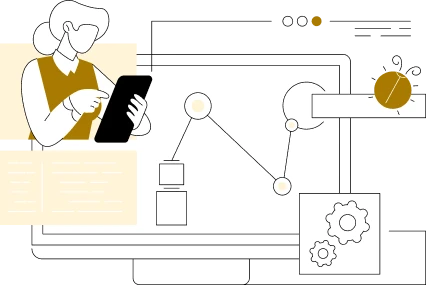- The Predictive Analytics Revolution in 2025
- Understanding the Role of Predictive Analytics in Software Development
- Key Features of Predictive Analytics Software Development
- Data Integration
- Advanced Analytics
- Visualization Tools
- Scalability
- Security Measures
- User-Friendly Interface
- AI-Powered Capabilities
- Business Benefits of Implementing Predictive Analytics Software
- Enhanced Product Quality
- Accelerated Development Cycles
- Cost Reduction
- Improved Customer Satisfaction
- Data-Driven Decision Making
- Revenue Growth & Customer Insights
- Faster Time-to-Market for Products/Services
- Proactive vs. Reactive Business Strategies
- Risk Management and Fraud Detection
- Industry-Specific Use Cases of Predictive Analytics in Software Development
- Healthcare: Predictive Diagnostics and Patient Outcome Forecasting
- Finance: Fraud Detection and Risk Management
- Manufacturing: Predictive Maintenance and Quality Control
- Retail & E-commerce: Inventory Management and Personalized Recommendations
- Logistics: Route Optimization and Demand Forecasting
- Entertainment: Personalized Content Recommendations
- The Predictive Analytics Development Process
- 1. Strategic Planning & Discovery Phase
- 2. Data Collection
- 3. Data Preparation
- 4. Model Building & Training
- 5. Model Evaluation
- 6. Deployment & Integration
- 7. Monitoring and Maintenance
- Predictive Analytics Software Development Best Practices
- Custom Predictive Analytics Software Development Costs
- Predictive Analytics Software Development Challenges and Solutions
- Data Quality
- Resource Allocation
- Ethical Implications
- Model Complexity
- Integration Issues
- Future Trends in Predictive Analytics for Software Development
- Why Appinventiv Excels in Predictive Analytics Development?
- FAQs
Key Takeaways
- Predictive analytics helps businesses shift from “what has happened” to “what will happen,” enabling proactive strategies rather than reactive ones.
- Real-time analytics and AI integration are driving the growth of predictive analytics, making it more accurate, accessible, and critical for business success.
- Custom predictive analytics solutions can enhance customer satisfaction, reduce costs, and increase profitability by predicting future behavior and demand.
- Predictive analytics development costs range from $40,000 for an MVP to $400,000+ for enterprise-level platforms.
“The world is drowning in data, and businesses that can transform this deluge into foresight are the ones truly thriving.”
Let’s picture this:
- Netflix’s recommendation engine predicts what you’ll want to watch next with 80% accuracy.
- Amazon anticipates your shopping needs before you realize them.
- Spotify curates the best playlist based on your mood.
What do these industry giants have in common? They have all mastered the art of predictive analytics software development, creating experiences that seem almost magical to users while generating billions in revenue.
How?
Predictive analytics platform development is transforming industries by turning raw data into actionable insights. This enables companies to anticipate customer needs, manage inventory effectively, reduce costs, and drive business growth.
McKinsey reports that data-driven organizations are 23 times more likely to acquire customers and 19 times more likely to be profitable. With the advent of real-time predictive analytics software development, the demand for these capabilities is set to grow. For entrepreneurs, adopting such a product development approach can be a highly profitable move, yielding unmatched efficiency and a distinct market advantage.
Start your predictive analytics journey and discover how predictive analytics can increase ROI and deliver the competitive advantage your organization needs.
The Predictive Analytics Revolution in 2025
The landscape of predictive analytics software development has undergone significant evolution. From startups seeking competitive advantages to enterprises planning digital transformation, custom predictive analytics software development has become a dire necessity for all, not a luxury.
According to MarketsAndMarkets, the global predictive analytics market is projected to reach $28.1 billion by 2026, up from $10.5 billion in 2021, with a compound annual growth rate (CAGR) of 21.7%.

What’s driving this explosive growth?
The convergence of artificial intelligence, machine learning, and real-time data processing capabilities has made predictive analytics more accurate, accessible, and actionable than ever before.
AI-driven analytics for inventory management have helped businesses reduce costs by 20-30% and improve customer satisfaction by ensuring that products are always in stock (McKinsey & Company)
Modern businesses are no longer asking if they should invest in predictive analytics; they are asking how quickly they can implement it.
So, if you are ready to leverage these advantages, building a custom predictive analytics software development platform is your secret weapon that can skyrocket your success in a matter of minutes. Companies working with a custom software development Dallas partner can accelerate implementation while ensuring the solution is tailored to their market and business needs.
Understanding the Role of Predictive Analytics in Software Development
Predictive analytics in software development represents a paradigm shift from reactive to proactive business intelligence. At its core, it involves creating sophisticated algorithms that analyze historical and real-time data to forecast future trends, behaviors, and outcomes with remarkable precision. This goes beyond traditional reporting by predicting what will happen, rather than what has happened.
Unlike traditional analytics, which reflects past data, predictive analytics forecasts future trends, helping businesses act before problems arise. This capability transforms software from mere data collection tools into intelligent decision-making partners that anticipate user needs, market changes, and operational challenges before they occur.
Key Features of Predictive Analytics Software Development
Modern predictive analytics platform development necessitates a comprehensive set of features that work in tandem to deliver accurate and actionable insights. Understanding these core capabilities is essential for organizations planning their analytics strategy, ensuring the solution can handle complex data environments and provide the foresight needed for competitive advantage. These features underpin the ability to transform raw data into valuable predictions. Below are some of the key features of predictive analytics software development:
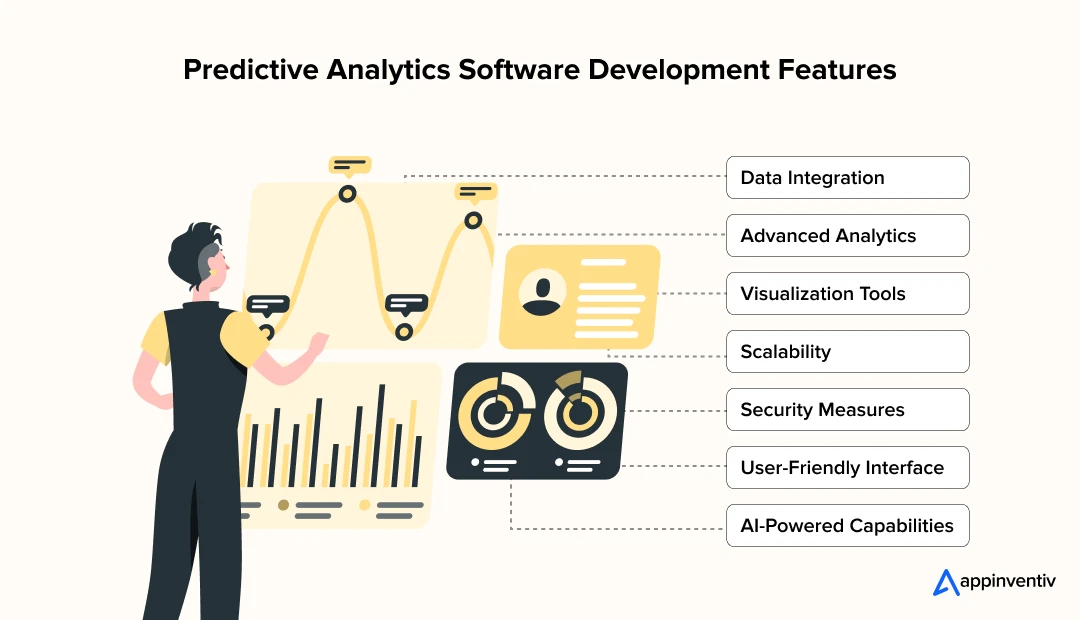
Data Integration
A key feature of predictive analytics software is its ability to integrate with various data sources, including CRM systems, databases, and external application programming interfaces (APIs). Seamless data integration is essential for building accurate predictive models, as it ensures that the software has access to all relevant datasets. This includes real-time data from sensors, historical data from previous transactions, and external data sources such as social media or weather data.
For example, predictive models in the retail and ecommerce industry often need data from inventory management systems, customer behavior data from web analytics, and sales data from past campaigns to generate accurate forecasts.
Advanced Analytics
Advanced analytics features, including deep learning and machine learning algorithms, are essential for developing powerful predictive models. These algorithms allow businesses to analyze complex datasets and identify patterns that are not immediately obvious to human analysts.
For example, in a predictive analytics platform for automated forecasting, algorithms like regression analysis, decision trees, and neural networks can be applied to predict future demand or customer behavior with high accuracy.
Visualization Tools
Interactive dashboards and data visualization tools are essential for presenting the results of predictive analytics in a clear and understandable format. These tools enable decision-makers to view trends, patterns, and predictions at a glance, without needing to manually interpret complex data sets.
Power BI and Tableau are popular tools often integrated with predictive analytics software to provide users with real-time data insights and visualizations that help them make data-driven decisions.
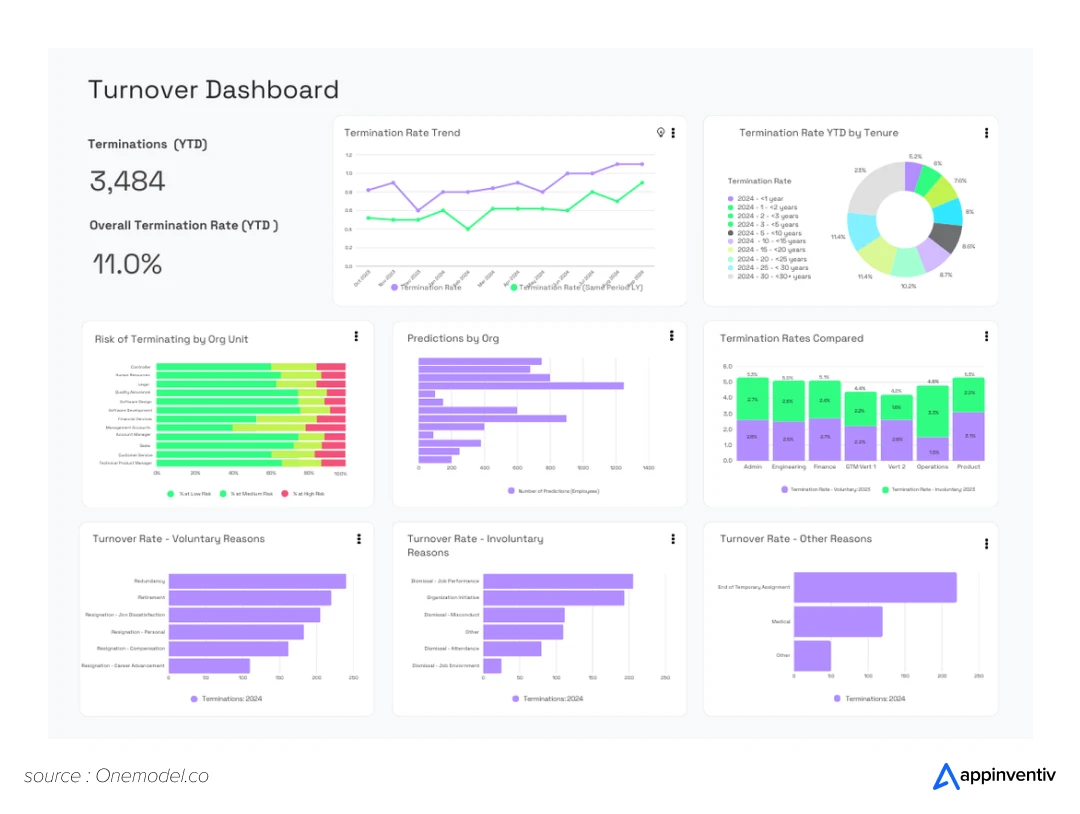
Scalability
As businesses grow, so do their data requirements. Predictive analytics platforms must be scalable to accommodate increasing data volumes without compromising performance. The ability to scale ensures that businesses can continue to make accurate predictions as their operations expand and evolve.
For instance, cloud-based platforms offer scalability, allowing businesses to increase their storage and processing power as needed, without incurring significant investments in on-premises hardware.
Security Measures
Given the sensitive nature of the data being processed, particularly in industries such as finance and healthcare, predictive analytics software must meet the highest security standards. This includes data encryption, compliance with regulations like GDPR and HIPAA, and robust access control systems to ensure that only authorized personnel can access sensitive data.
User-Friendly Interface
While predictive analytics involves complex algorithms and models, it’s essential that the software has an intuitive, user-friendly interface. This enables non-technical users, such as business leaders and marketers, to easily interpret results and apply them to their operations.
An easy-to-navigate interface ensures that predictive analytics solutions are accessible to all stakeholders, facilitating the incorporation of predictive insights into everyday decision-making processes.
AI-Powered Capabilities
Incorporating artificial intelligence into predictive analytics software enhances its capabilities by automating data analysis, model training, and prediction generation. AI-driven platforms can identify new patterns, improve predictive accuracy over time, and provide insights that traditional analytics tools may have overlooked.
Business Benefits of Implementing Predictive Analytics Software
The benefits of predictive analytics software development extend far beyond simple forecasting capabilities, creating a ripple effect of improvements across all business functions. From optimizing resources to enhancing customer experience, integrating predictive analytics into your software development lifecycle can lead to significant improvements in operational efficiency and informed decision-making. Let’s dive into some of the key benefits.
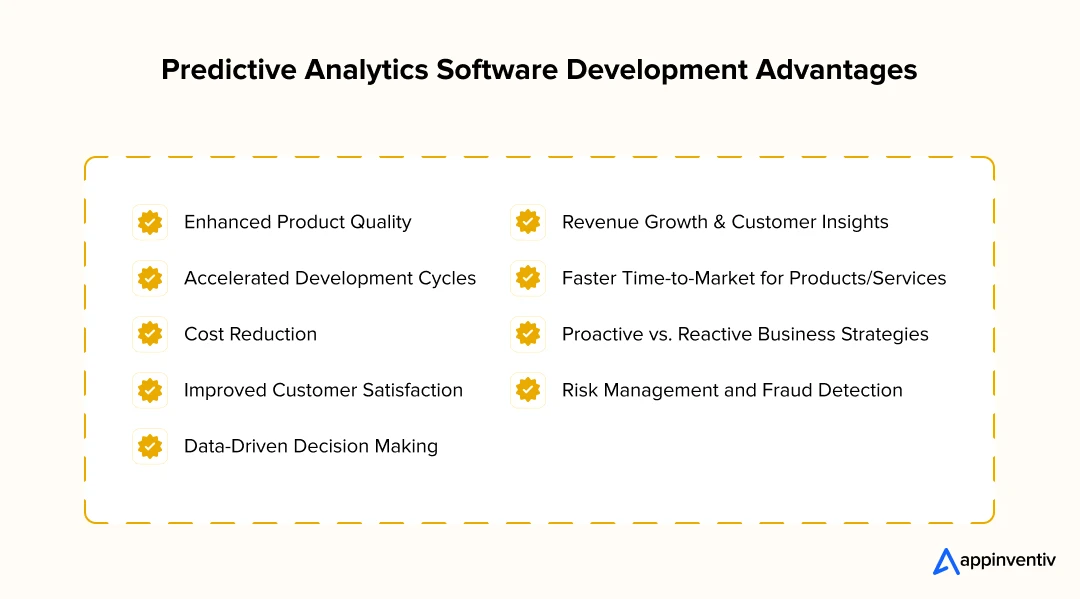
Enhanced Product Quality
By analyzing usage patterns, error logs, and customer feedback, predictive models can identify potential software bugs or design flaws before they become critical issues. This enables proactive fixes, significantly enhancing the overall quality and reliability of products.
For example, predictive analytics in manufacturing and tech platforms can forecast system failures before they occur, enabling companies to take corrective action and prevent downtime, ultimately saving both time and money.
Accelerated Development Cycles
Predictive analytics can streamline the software development lifecycle. For instance, predicting resource needs, identifying potential bottlenecks in advance, or even automating certain testing phases can significantly reduce development time and accelerate time-to-market for products and services.
Cost Reduction
By improving accuracy in forecasting, predictive analytics helps reduce unnecessary costs. In software development, this means fewer resources spent on debugging and more efficient project management. Additionally, predictive models can optimize inventory levels in e-commerce, ensuring that products are stocked based on expected demand, thereby reducing overstocking and stockouts.
For example, Hypersonix AI highlighted that AI-driven demand forecasting can reduce supply chain errors by 20% to 50%, leading to a 65% decrease in lost sales.
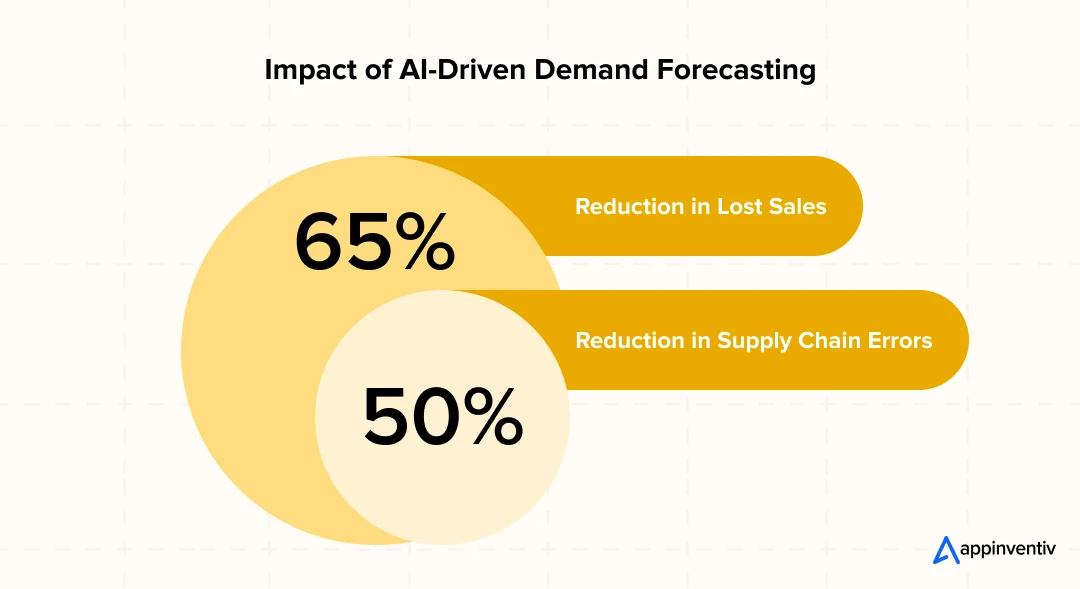
Improved Customer Satisfaction
Predictive analytics enables businesses to create personalized customer experiences by forecasting which products, services, or features customers are most likely to engage with. Understanding customer preferences, predicting churn, and offering customized recommendations leads to a more engaging and satisfying user experience. This translates to increased customer loyalty and advocacy.
Data-Driven Decision Making
In today’s fast-paced business environment, relying on intuition alone is no longer enough. Predictive analytics enables data-driven decision-making by providing real-time insights into business operations, customer behaviors, and market conditions. This empowers leaders to make informed decisions backed by data, thereby reducing the risks associated with traditional decision-making methods.
Revenue Growth & Customer Insights
One of the most powerful benefits of predictive analytics software development is its ability to drive revenue growth. By forecasting customer behavior, predictive analytics enables businesses to target high-value customers with tailored offerings. In ecommerce, this means better product recommendations, more personalized pricing strategies, and smarter marketing initiatives.
Faster Time-to-Market for Products/Services
Predictive analytics software development can speed up the time it takes to bring new products or services to market. By forecasting market trends, customer preferences, and potential risks, businesses can confidently launch new offerings, knowing they are aligned with customer needs and market conditions.
Proactive vs. Reactive Business Strategies
With predictive analytics, businesses no longer need to wait for problems to arise. Instead, they can predict potential challenges and address them before they escalate. This proactive approach leads to fewer surprises, smoother operations, and more agile businesses.
Risk Management and Fraud Detection
Predictive analytics plays a crucial role in identifying and mitigating risks before they become significant issues. Whether it’s fraud detection in finance, operational risks in manufacturing, or cybersecurity threats in tech, predictive analytics helps businesses identify vulnerabilities early, allowing them to take action before damage occurs.
Also Read: AI in Risk Management: Key Use Cases
Industry-Specific Use Cases of Predictive Analytics in Software Development
Predictive analytics is not a one-size-fits-all solution; it is tailored to meet the unique needs of various industries. By analyzing historical data and utilizing machine learning models, businesses across multiple sectors can make more informed decisions, optimize their operations, and drive growth.
Here are some compelling applications of predictive analytics software, along with some real-world examples of predictive analytics in software development:

Healthcare: Predictive Diagnostics and Patient Outcome Forecasting
In healthcare, predictive analytics is being used to improve patient care by forecasting health risks, diagnosing diseases early, and predicting patient outcomes. Predictive models can analyze vast amounts of medical data, including patient history, lab results, and genetic information, to anticipate conditions such as heart disease, diabetes, or cancer.
Real Example: Humana
Humana, a leading healthcare company, utilizes predictive analytics to enhance care management by identifying patients at risk of developing chronic conditions, thereby enabling early interventions and improved outcomes. This has led to significant reductions in emergency room visits and hospital readmissions.
Finance: Fraud Detection and Risk Management
In the finance industry, predictive analytics enables financial institutions to detect fraud, assess credit risk, and forecast market trends. By analyzing transaction data, customer behavior, and historical financial patterns, predictive models can identify unusual activities, flag potential fraud, and provide more accurate credit scoring.
Real Example: American Express
American Express uses predictive analytics to detect fraudulent transactions by analyzing transaction patterns in real-time. The system flags suspicious activities, significantly reducing fraud losses and improving customer security.
Manufacturing: Predictive Maintenance and Quality Control
Manufacturers use predictive analytics to optimize machinery performance and predict failures before they happen. By monitoring equipment in real-time, predictive models can forecast when a machine is likely to break down, reducing downtime and maintenance costs. Additionally, predictive models help improve quality control by identifying defects early in the production process.
Real Example: General Electric (GE)
General Electric (GE) leverages predictive analytics to monitor turbines and other industrial machinery. Their Predix platform analyzes sensor data to predict when equipment needs maintenance, thus reducing downtime and increasing efficiency.
Also Read: Manufacturing Analytics Software Development Cost
Retail & E-commerce: Inventory Management and Personalized Recommendations
In the retail and e-commerce industries, predictive analytics is a game-changer for inventory management, demand forecasting, and personalized product recommendations. By analyzing sales data, customer behavior, and market trends, predictive models can forecast which products will be in high demand, allowing retailers to optimize inventory and pricing strategies. Furthermore, personalized recommendations drive customer satisfaction and increase conversion rates.
Real Example: Amazon
Amazon uses predictive analytics for personalized product recommendations. Their system analyzes customer purchase history and browsing behavior to suggest products that customers are likely to buy, contributing to Amazon’s massive sales growth.
Logistics: Route Optimization and Demand Forecasting
In logistics, predictive analytics helps optimize delivery routes, forecast demand, and improve fleet management. By analyzing traffic patterns, weather data, and delivery schedules, businesses can ensure timely deliveries, reduce fuel costs, and enhance operational efficiency. Predictive models also allow companies to anticipate demand and adjust logistics operations accordingly.
Real Example: UPS
UPS uses predictive analytics for route optimization, helping drivers avoid traffic delays and reduce fuel consumption. Their ORION system analyzes millions of data points in real time to suggest the most efficient delivery routes, saving the company millions of dollars annually.
Also Read: Use Cases & Benefits of Predictive Analytics in Oil and Gas
Entertainment: Personalized Content Recommendations
In the entertainment industry, predictive analytics plays a pivotal role in personalizing user experiences and optimizing content recommendations. By analyzing viewers’ historical data, including watch history, viewing time, and ratings, predictive models can recommend content tailored to individual preferences, thereby increasing user engagement and retention. These recommendations go beyond basic algorithms, leveraging machine learning to predict what users are most likely to enjoy next.
Real Example: Netflix
Netflix’s recommendation engine is a prime example of predictive analytics in the entertainment industry. Netflix’s system analyzes user behavior, preferences, and viewing patterns to offer tailored content suggestions.
Remarkably, over 80% of the content viewed on the platform is discovered through these personalized recommendations, which essentially predict what millions of users want to watch before they even know it themselves.
Here is a brief table outlining the key use cases of predictive analytics in different industries:
| Industry | Use Cases of Predictive Analytics in Software Development |
|---|---|
| Healthcare | Predictive diagnostics, patient outcome forecasting, and resource planning |
| Finance | Fraud detection, credit scoring, risk assessment |
| Manufacturing | Predictive maintenance, quality control, supply chain optimization |
| Retail & Ecommerce | Inventory optimization, personalized recommendation engines, and churn prediction |
| Logistics | Route optimization, demand forecasting, and fleet management |
| Entertainment | Demand forecasting, personalized recommendation |
Netflix’s predictive analytics is powering 80% of content discoveries and enhancing engagements. Bless your business with such predictive analytics capabilities now.
The Predictive Analytics Development Process
Developing a robust predictive analytics solution requires a structured and iterative approach, moving from conceptualization to continuous refinement. This comprehensive predictive analytics software development process ensures a successful outcome, transforming raw data into actionable insights.
This paves the way for advanced capabilities, including predictive analytics software for automated forecasting and informed decision-making. It’s a journey that demands precision at every stage to build impactful solutions.

1. Strategic Planning & Discovery Phase
Before diving into the technical aspects of predictive analytics software development, it’s essential to define the project’s objectives. This involves identifying key business problems that predictive analytics can solve.
For example, an ecommerce business may want to predict customer churn or optimize inventory management. By understanding the specific goals, developers and stakeholders can ensure the project stays focused on solving real-world problems and generating tangible results.
2. Data Collection
The foundation of any predictive analytics software development is data. Without high-quality data, the software’s predictions will be inaccurate and unreliable. In this phase, relevant data is gathered from various sources such as:
- Historical data (e.g., past sales, customer interactions)
- Real-time data (e.g., customer behavior, website traffic)
- External data (e.g., market trends, weather patterns)
For ecommerce businesses, this might include collecting customer purchase history, product preferences, and browsing behavior to build more accurate predictive models.
3. Data Preparation
Once data is collected, it must be cleaned, transformed, and structured for analysis. This stage is crucial for ensuring that the data is accurate and in a format that predictive algorithms can use. Data preparation includes tasks like:
- Removing duplicates and correcting errors
- Handling missing or incomplete data
- Normalizing data to ensure consistency across datasets
In predictive analytics, “garbage in, garbage out” applies: poor-quality data leads to poor predictions. A well-prepared dataset forms the bedrock of reliable predictive models.
4. Model Building & Training
In this phase, data scientists develop AI and ML-driven predictive models that will analyze the prepared data and generate predictions. Several types of predictive models can be used, depending on the business needs:
- Linear Regression for predicting continuous variables (e.g., sales revenue).
- Classification Algorithms for predicting categorical outcomes (e.g., customer churn).
- Time Series Models for forecasting future trends based on historical data.
Models are trained using historical data, allowing them to learn from patterns and make predictions for future scenarios. Training involves selecting appropriate algorithms, fine-tuning parameters, and testing the model to ensure accuracy.
5. Model Evaluation
Once a predictive model is built, it must be rigorously tested to ensure its accuracy and reliability. This involves evaluating the model’s performance using metrics such as:
- Accuracy: How often the model’s predictions are correct.
- Precision: How many of the predicted outcomes are true positives?
- Recall: The proportion of actual positives correctly identified by the model.
- F1 Score: The balance between precision and recall.
For example, an e-commerce business might evaluate the accuracy of a sales forecast model by comparing predicted sales against actual sales data over a specified period. If the model’s predictions are significantly off, it may require adjustments.
6. Deployment & Integration
After evaluation, the predictive model is ready for deployment. This step involves integrating the model into the existing software development lifecycle. Whether it’s an e-commerce platform, a financial service application, or healthcare software, the predictive model is embedded into the business processes, providing real-time insights.
In real-time predictive analytics software development, integration is crucial because the model needs to process and deliver predictions instantly, such as customer recommendations or fraud alerts, as data is collected.
7. Monitoring and Maintenance
Once deployed, the predictive model needs to be monitored regularly to ensure its predictions remain accurate as business conditions change. This phase also involves model maintenance, which can include:
- Retraining the model with new data to improve accuracy.
- Fine-tuning algorithms to adapt to changing trends.
- Updating software to incorporate new features or enhancements.
For example, a predictive model for inventory management may need to be retrained annually to account for shifts in customer purchasing behavior.
Predictive Analytics Software Development Best Practices
To ensure a successful predictive analytics software development lifecycle, following the best practices is crucial. Here are the most common ones:
- Start Small, Scale Big: Begin with a well-defined, manageable pilot project with clear objectives to demonstrate value before scaling to more complex initiatives.
- Embrace Data Quality from the Outset: Poor data quality is the single biggest predictor of project failure. Implement robust data governance and cleansing processes.
- Foster Collaboration: Bridge the gap between data scientists, software engineers, and business stakeholders. Effective communication is paramount.
- Prioritize Explainability (XAI): Especially in sensitive domains, ensure your models are interpretable. This builds trust, facilitates debugging, and helps meet regulatory requirements.
- Adopt an Iterative & Agile Approach: Predictive analytics development is rarely linear. Embrace agile methodologies to allow for flexibility, continuous feedback, and rapid iteration.
- Ensure Security and Compliance: Integrate security protocols and privacy-by-design principles from the very beginning of the predictive analytics software development process.
Custom Predictive Analytics Software Development Costs
Predictive analytics software development costs vary widely depending on several critical factors, including the complexity of predictive models, the volume and variety of data sources, integration requirements, and the level of customization.
On average, software development costs range from $40,000 for a basic Minimum Viable Product (MVP) to over $400,000 for a full-featured, enterprise-grade solution tailored to complex business needs.
Besides initial development, ongoing maintenance costs play a crucial role in the total investment. These include continuous model retraining, software updates, data storage, security enhancements, and technical support. Maintenance typically accounts for 15-25% of the initial development cost annually, ensuring the predictive analytics software remains accurate, secure, and aligned with evolving business goals.
Here’s a brief table outlining custom predictive analytics software development costs and timeline for various types of solutions:
| Platform Type | Description | Estimated Cost | Estimated Timeline |
|---|---|---|---|
| MVP Development | Core features with limited data integration | $40,000 – $80,000 | 4-6 months |
| Mid-Level Custom Solution | Advanced analytics, moderate integration | $80,000 – $200,000 | 6-8 months |
| Enterprise-Grade Platform | Full-scale, multi-source data, real-time forecasting | $200,000 – $400,000+ | 8-12+ months |
Partnering with experienced predictive analytics software companies can help optimize predictive analytics software development costs while ensuring the solution scales with your business needs.
Predictive Analytics Software Development Challenges and Solutions
While predictive analytics software development offers tremendous value, it’s not without its challenges. From data quality issues to model complexity and integration concerns, businesses must navigate several obstacles during the development and implementation phases. Let’s explore some of the key challenges and potential solutions.
Data Quality
Challenge: The adage “garbage in, garbage out” applies perfectly here. Poor data quality (inaccuracies, inconsistencies, missing values) can severely compromise model accuracy.
Solution: Invest heavily in robust data governance frameworks, automated data validation, and continuous data cleansing processes.
Resource Allocation
Challenge: Lack of skilled data scientists, ML engineers, and adequate computational resources can hinder progress.
Solution: Consider outsourcing product development to specialized software development service providers, invest in upskilling existing teams, and leverage cloud-based platforms for scalable computing power.
Ethical Implications
Challenge: Concerns around data privacy, algorithmic bias, and fairness in predictions are growing. For instance, Gartner predicted in 2024 that 60% of organizations will fail to realize the anticipated value of their AI use cases by 2027 due to incohesive ethical governance frameworks.
Solution: Implement privacy-by-design principles, conduct regular bias audits on data and models, ensure transparency with XAI, and establish clear accountability for AI-driven decisions.

Model Complexity
Challenge: Highly sophisticated models can be “black boxes,” making it difficult to understand how they arrive at predictions.
Solution: Prioritize Explainable AI (XAI) techniques and tools, balance model sophistication with interpretability, and involve domain experts in validating model outputs.
Integration Issues
Challenge: Merging new predictive analytics systems with existing, often siloed, software environments can be complex.
Solution: Adopt API-first development strategies, leverage modern integration platforms (iPaaS), and plan for integration early in the predictive analytics software development process.
Future Trends in Predictive Analytics for Software Development
As we move further into 2025 and beyond, predictive analytics software development is evolving rapidly, driven by advances in artificial intelligence and machine learning.
AI-powered models: One of the most significant trends is the deeper integration of AI-powered models that can learn continuously from streaming data, enabling the development of real-time predictive analytics software. This shift enables businesses to make instantaneous decisions, from dynamic pricing in e-commerce to proactive maintenance in manufacturing, thereby dramatically improving responsiveness and efficiency.
Automation: Automation is another major trend transforming the development lifecycle. The rise of AutoML (Automated Machine Learning) tools reduces the need for extensive manual model tuning and accelerates deployment. This democratization of predictive analytics empowers smaller teams and entrepreneurs to build sophisticated forecasting tools without massive data science resources, lowering barriers to entry and fostering innovation.
Explainability AI: Explainability and transparency are also gaining prominence. These models make them more interpretable for stakeholders, ensuring that decisions driven by analytics are understandable and trustworthy — a critical factor for the adoption of predictive analytics in industries such as supply chain, healthcare, and finance.
Industry-specific Platforms: Lastly, industry-specific solutions continue to grow in sophistication. Tailored predictive analytics platforms that address business gaps and niche challenges—whether optimizing inventory in retail or forecasting patient outcomes in healthcare—are becoming standard.
This specialization enhances accuracy and ROI by aligning analytics tightly with domain expertise, pushing the boundaries of what predictive software can achieve across sectors.
Why Appinventiv Excels in Predictive Analytics Development?
As a leading software development service provider, Appinventiv combines technical excellence with deep industry expertise to deliver transformative predictive analytics solutions. With over 1,600 technology evangelists and more than 10 years of industry experience, we understand the unique challenges and opportunities that businesses face in various sectors.
Our proven track record includes the successful development and implementation of over 3,000 solutions for Fortune 500 companies, innovative startups, and government clients across the healthcare, finance, retail, and manufacturing sectors. We leverage cutting-edge technologies, including AI, machine learning, and cloud computing, to create scalable solutions that grow with your business.
What sets us apart is our comprehensive data analytics services that encompass strategy consulting, custom development, system integration, legacy system modernization, and ongoing support, ensuring long-term success.
Contact us today for a quick consultation and discover how predictive analytics software development can transform your business operations, improve customer satisfaction, and drive sustainable growth.
FAQs
Q. What is predictive analytics, and how does it work?
A. Predictive analytics uses statistical algorithms, machine learning techniques, and historical data to predict future events or trends. By analyzing patterns in data, predictive models forecast outcomes such as customer behavior, market trends, or operational risks. These insights help businesses make data-driven decisions to optimize performance, improve customer satisfaction, and reduce costs.
For example, in an ecommerce app, big data predictive analytics tools development can help forecast product demand, recommend products to customers, or predict when a customer is likely to make a purchase.
Q. What is predictive analytics for customer support?
A. Predictive analytics for customer support helps businesses anticipate customer issues before they arise. By analyzing historical customer interactions, sentiment analysis, and usage patterns, predictive models can forecast common support inquiries, product issues, or even customer churn. This allows businesses to proactively resolve issues, improve customer satisfaction, and reduce the volume of support requests.
Q. What factors determine the cost of predictive analytics solutions development?
A. The cost of predictive analytics software development depends on several factors:
- Data Complexity: The volume, variety, and quality of the data being analyzed.
- Customization: The extent to which the software needs to be tailored to your specific business needs.
- Model Complexity: More sophisticated models, such as deep learning algorithms, require more time and expertise to develop.
- Integration: The complexity of integrating the predictive analytics solution into your existing systems.
- Ongoing Maintenance: The cost of monitoring, updating, and maintaining the predictive models over time.
Typically, businesses can expect to invest in the range of $40,000 to $400,000+ for custom predictive analytics development, depending on these factors.


- In just 2 mins you will get a response
- Your idea is 100% protected by our Non Disclosure Agreement.

How to Build an RFID Asset Tracking System in The UAE?
Key takeaways: The success of an RFID asset tracking system is dictated by the quality of the custom software and middleware, which must transform voluminous raw tag data into actionable intelligence. Implementation of RFID systems requires a managed, multi-stage process, moving logically from Integration Consulting and architectural design to Continuous Monitoring and Optimization, which is…

How to Build a White-Label Grievance Management Software? Process, features, costs
Key Takeaways White-label grievance management software allows businesses to quickly implement, rebrand, and scale solutions without reinventing the wheel. The development process involves multiple stages, including requirement gathering, workflow design, tech stack selection, and ensuring compliance and scalability. Key features include multi-channel intake, automated routing, customizable workflows, AI-driven categorization, and built-in compliance and security. Costs…
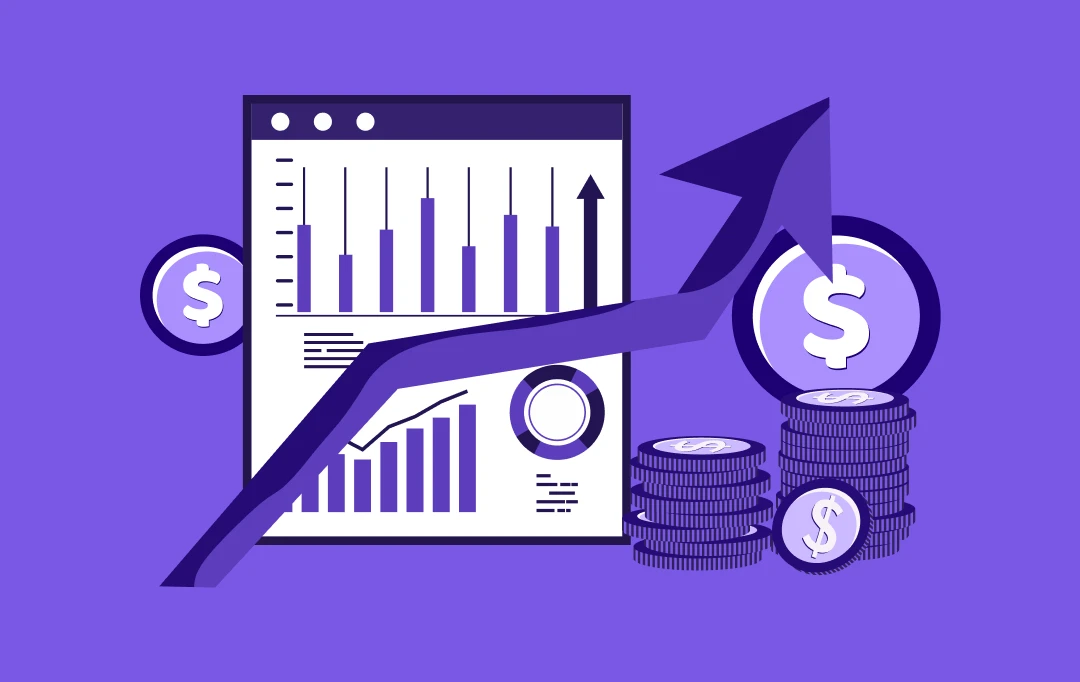
How to Build a Demand Forecasting Software?
Key Takeaways Modern demand forecasting software leverages AI and real-time data to boost accuracy and efficiency. Custom solutions integrate seamlessly with ERP, CRM, and inventory systems for end-to-end visibility. Accurate forecasting reduces costs, optimizes resources, and improves customer satisfaction. Cloud-based, scalable platforms make advanced demand planning accessible to businesses of any size. Demand forecasting used…
